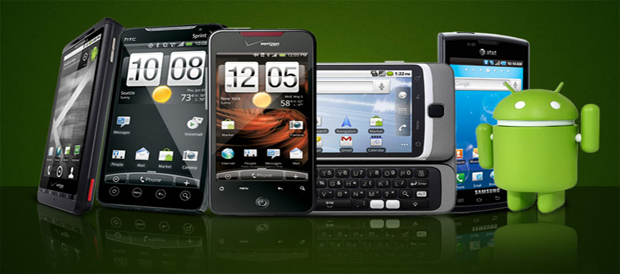A lot of new Android phones are coming up, your old phones are look weaker and weaker everyday, in a year the mobile world has been up-taken by a revolution in both hardware and software. With the speed of these changes, what should you do? Shall I buy a new phone, upgrade my old one now or wait for everything to settle?
So to answer this question lets compare the biggest chipsets in smartphones today.
1. Snapdragon 1st Generation
Android saw its first snapdragon phone last year, the Nexus One aka the Google phone. The CPU still manages to keep pace with most games. It’s not like any other Cortex A8 floating around because of Qualcomm’s various modifications to ARM’s architecture.
QSD 8250 (GSM) and QSD8650 (CDMA) have the following features:
- Scorpion 1 GHz CPU
- Low-power 65nm process technology
- High-definition (720p) video recording and playback up to 30 frames per second
- Multiple video codecs: (MPEG-4, H.264, H.263, VC-1, Sorenson Spark, VP6)
- GPU – 3D graphics with up to 22M triangles/sec and 133M 3D pixels/sec
- Multiple audio codecs: (AAC+, eAAC+, AMR, FR, EFR, HR, WB-AMR, G.729a, G.711, AAC stereo encode)
It looks like just another Cortex A8 chipset but it isn’t. The scorpion CPU is where snapdragons take the lead:
From www.greenecomputing.com
The Scorpion core is an a 1-GHz control processor based on ARM’s Cortex instruction set supported by an array of 600-MHz DSP and accelerator cores for baseband and video processing that offer 128-bit single instruction multiple data (SIMD) functionality. Thus, the Scorpion core can process SIMD instructions in 128-bit-wide chunks, while most other Cortex based chips are restricted to 64 bits. Scorpion also has a deeper pipeline, which includes VFP commands, while VFP commands are not pipelined in the Cortex.
It’s one of the fastest Cortex A8 CPUs around (the other being the second gen.) It’s the king of calculations and math scoring whopping linpack and CPU benchmark scores.
Now to its GPU. It ships with the Adreno 200 GPU which today is pretty meh. At 22m triangles/second its like an underdog now but still good enough to get you through daily gaming needs. It can play Dungeon Defenders pretty well which today is the most resource consuming android game. So its not outdated or useless yet, you can see it going good for like 6 more months until the best phones start shipping and getting wildly adopted.
2. Hummingbird
Hummingbird is a pretty familiar name to anyone active in the smartphone world. It’s shipping with the most successful series of android phone yet, the Samsung Galaxy S series. Developed by Samsung and Intrinsity it has a normal cortex A8 CPU model number -S5PC110 with a kick-ass GPU, known as the PowerVR SGX540 developed by Imagion Technologies which pushes out a whooping 90 million triangles of which its pretty much bottlenecked due to BUS speeds. Clock to clock speed of Hummingbird is pretty low compared to Snapdragon. So overall experience is slower seeing android has no hardware acceleration in UI. It still has one of the best GPUs to-date so gaming performance is the best.
So the conclusion if you can compromise on speed (Galaxy S are known to be really laggy phones) for gaming then you should probably go for this. It isn’t gonna be outdated real soon seeing that even today devices are shipping with slow CPU and slower CPUs are being developed (Broadcom dual core)
Editors Note: Its worth noting that latency on Hummingbird A8-based cores stems from Samsung’s use of the RFS file system in their builds of Android. File systems are the way storage interacts with the device reading them, and unreliable file systems mean unreliable file transfers. Much of the lag associated with these phones is easily fixed by replacing it with the more modern, and standard EXT-3/4 file systems, which do not experience the same skipping artifact. (UPDATED) thanks, iofthestorm.
3. 2nd Gen Snapdragon
In our opinion, this is the king of chipsets currently shipping on smartphones. It’s epicly powered CPU ships with an improved GPU. It ships with a dye-reduced Scorpion core with a transistor size of 45nm meaning it consumes less power, making it capable of greater overclocks (with rooted hardware), potentially meaning faster speeds. There are 2 versions of this 2nd generation Snapdragon – 7×30 and 8×55, from Qualcomm
- Scorpion 1 GHz CPU with 8×55 and Scorpion 800mhz CPU with 7×30
- Low-power 45nm process technology for higher integration and performance
- High-definition (720p) video recording and playback up to 30 frames per second
- Multiple video codecs: (MPEG-4, MPEG-2, H.264, H.263, VC-1, DivX, DivX 3.11, Sorenson Spark, On2 VP6)
- High-performance GPU – up to 41M triangles/sec and 245M 3D pixels/se with dedicated 2D Open VG graphics hardware
- Multiple audio codecs: (AAC+, eAAC+, AMR, FR, EFR, HR, WB-AMR, G.729a, G.711, AAC stereo encode
This is in a pretty win/win situation. The Adreno 205 GPU is one of the fastest GPUs yet in terms of from shader performance and polygon rendering. This chipset also support hardware acceleration for Adobe flash 10.1 so no more lag while watching flash videos on your phone.
It has the fastest shader performance in any GPU shipped yet. In OpenGL2.0 benchmark out of the 31 areas tested Adreno 205 wins in 19 whereas the SGX540 in 12.
The results table:
| HTC Desire HD / Adreno 205 | Samsung Galaxy S / SGX540 |
GLBenchmark 2.0 Egypt : | 2043 Frames (18.1 Fps) | 2423 Frames (21.4 Fps) |
GLBenchmark 2.0 Egypt FSAA : | 1705 Frames (15.1 Fps) | 1957 Frames (17.3 Fps) |
GLBenchmark 2.0 Egypt FSAA Fixed Time : | 194328 ms | 170861 ms |
GLBenchmark 2.0 PRO : | 1269 Frames (25.4 Fps) | 1931 Frames (38.6 Fps) |
GLBenchmark 2.0 PRO FSAA : | 973 Frames (19.5 Fps) | 1441 Frames (28.8 Fps) |
GLBenchmark PRO FSAA Fixed Time : | 69861 ms | 51186 ms |
|
|
|
Array test: uniform array access : | 2325 kVertex/s (17.7 Fps) | 2026 kVertex/s (15.4 Fps) |
|
|
|
Branching test: balanced : | 5484 kShader/s (10.6 Fps) | 2862 kShader/s (5.6 Fps) |
Branching test: fragment weighted : | 11726 kFragment/s (30.5 Fps) | 9996 kFragment/s (26.0 Fps) |
Branching test: vertex weighted : | 2084 kVertex/s (15.9 Fps) | 2398 kVertex/s (18.3 Fps) |
|
|
|
Common test: balanced : | 3385 kShader/s (6.6 Fps) | Failed / Not supported |
Common test: fragment weighted : | 7872 kFragment/s (20.5 Fps) | Failed / Not supported |
Common test: vertex weighted : | 503 kVertex/s (3.8 Fps) | 2295 kVertex/s (17.5 Fps) |
|
|
|
Geometric test: balanced : | 3071 kShader/s (6.0 Fps) | 2862 kShader/s (5.6 Fps) |
Geometric test: fragment weighted : | 8654 kFragment/s (22.5 Fps) | 5082 kFragment/s (13.2 Fps) |
Geometric test: vertex weighted : | 820 kVertex/s (6.2 Fps) | 2398 kVertex/s (18.3 Fps) |
|
|
|
Exponential test: balanced : | 6121 kShader/s (11.9 Fps) | 3270 kShader/s (6.3 Fps) |
Exponential test: fragment weighted : | 14674 kFragment/s (38.2 Fps) | 7543 kFragment/s (19.6 Fps) |
Exponential test: vertex weighted : | 1124 kVertex/s (8.6 Fps) | 2379 kVertex/s (18.1 Fps) |
|
|
|
Fill test: texture fetch : | 182942 kTexels/s (7.4 Fps) | 73753 kTexels/s (3.0 Fps) |
|
|
|
For loop test: balanced : | 4175 kShader/s (8.1 Fps) | 3089 kShader/s (6.0 Fps) |
For loop test: fragment weighted : | 10598 kFragment/s (27.6 Fps) | 2333 kVertex/s (17.8 Fps) |
For loop test: vertex weighted : | 877 kVertex/s (6.7 Fps) | 2333 kVertex/s (17.8 Fps) |
|
|
|
Triangle test: textured : | 9266 kTriangles/s (70.6 Fps) | 4046 kTriangles/s (30.8 Fps) |
Triangle test: textured, fragment lit : | 7729 kTriangles/s (58.9 Fps) | 2806 kTriangles/s (21.4 Fps) |
Triangle test: textured, vertex lit : | 7715 kTriangles/s (58.7 Fps) | 3364 kTriangles/s (25.6 Fps) |
Triangle test: white : | 12118 kTriangles/s (92.3 Fps) | 5219 kTriangles/s (39.7 Fps) |
|
|
|
Trigonometric test: balanced : | 3244 kShader/s (6.3 Fps) | 2030 kShader/s (3.9 Fps) |
Trigonometric test: fragment weighted : | 8800 kFragment/s (22.9 Fps) | 2757 kFragment/s (7.2 Fps) |
Trigonometric test: vertex weighted : | 850 kVertex/s (6.5 Fps) | 1730 kVertex/s (13.2 Fps) |
|
|
|
Swapbuffer speed : | 592 (59.2 Fps) | 560 (56.0 Fps) |
This isn’t the only test in which Adreno 205 bests SGX540 but even in 3dmarkmobile benchmark:
This test was conducted by AndroidandMe and the G2 (with Adreno 205) easily bests Epic 4G (SGX540) in GPU tests. In Neocore tests it beats the Galaxy S, which uses the Hummingbird SOC (54 fps) by 3-4 fps (50-58fps)
CPU architecture is pretty much the same as that of the first generation snapdragon with the addition of smaller transistors (45nm), and a dedicated pipeline for low-power audio output at sleep. Speed is similar with lower clock speeds, because of a more efficient CPU core and manages to save power because of this. Quadrant too is pretty high on these phone nearing 2500 without any fakes or stuff.
4. TI OMAP 3630
This chipset is the underdog right now with Motorola being the only major TI partner in the US. A weak CPU is coupled with the weak SGX530 GPU. Its shipped with the current Motorola Droid (X,2) lineup. It’s built on the 45nm process Cortex A8 processor. It has 720p video encoding and decoding support. The GPU is on par with the Adreno 200 but has a weaker CPU. So I would seriously reconsider if investing in a device with this chipset.
5. Tegra 2
This is the chipset everyone is waiting for. Although it hasn’t yet shipped in any smartphones, it has shipped and is scheduled to ship in quite a few tablets. It’s gonna be powering one of the most awaited phones of the year, the Motorola ATRIX 4G the smartphone cum Laptop cum Media Center.
From Nvidia:
As the world’s first mobile super chip, NVIDIA Tegra™ 2 brings extreme multitasking with the first mobile dual-core CPU, the best mobile Web experience with up to two times faster browsing, hardware accelerated Flash, and console-quality gaming with an ultra-low power (ULP) NVIDIA GeForce GPU. Get never-before-seen experiences on a mobile device with NVIDIA Tegra.
Key Features:
- Dual-core ARM Cortex-A9 CPU — The world’s first mobile dual-core CPU for faster Web browsing, snappier response time, and overall better performance. The Cortex-A9 is the first mobile CPU with out of order execution for more efficient processing, resulting in a better overall experience.
- Ultra-low power (ULP) GeForce GPU — Architected for low-power applications, the ULP GeForce GPU delivers outstanding mobile 3D game playability and a visually engaging, highly-responsive 3D user interface.
- 1080p Video Playback Processor — Watch 1080p HD movies stored on your mobile device on your HDTV without compromising battery life.
- 1080p Video Encode Processor — Runs video encode algorithms to deliver full 1080p HD video streams for video recording and conferencing capabilities.
- Image Signal Processor (ISP) — Take sharp brilliant pictures with support for up to 12 MP cameras. The integrated image signal processor (ISP) includes proprietary algorithms that enable image and video stabilization, face tracking, advanced trick modes, light balance, edge enhancement, and noise reduction to deliver real-time photo enhancement capabilities.
- Audio Processor — Handles signal audio processing to deliver days of continuous 128kbps mp3 audio playback on a single battery charge.
- ARM7 Processor — Supports system management functions and several proprietary battery life extending features.
- High-Definition Digital Display Output — Tegra supports HDMI allowing you to connect to a full 1080p HDTV or other display and view your content on the big screen. 5.1 surround sound support fills your room with a theater-like experience.
- OpenGL® ES 2.0 Optimizations and Support — Ensures robust compatibility and performance for OpenGL applications.
- Global Power Management System — Numerous hardware monitors distributed across the Tegra architecture collect data on activity levels, frequency, temperature, and incoming request patterns. The data is used to determine the optimal operating condition to ensure that the processors are always running at the lowest possible power level while still delivering maximum performance when needed.
It’s dual core, potentially totaling 2GHz clock speed with dual-core enabled applications and games. 1080p encode and decode just killing off those expensive pocket camcorders, HDMI output in 1080p killing of those media centers. This is, in our opinion the best all-round chipset going to ship in future. It pushes out 71 million triangles for the GPU, lower than those of the SGX540 but SGX540 is limited by a lot of factors. This is just the start of the dual core revolution with Qualcomm claiming their dual core chipsets at 1.3ghz each kills the competition and their partner’s GPU, the Adreno 220 delivers performance near that of Xbox 360 and PS3 which is pretty impressive.
What about overclocking, isn’t that an option???
Requiring root, overclocking increases CPU speed and can increase GPU speed by a small margin by increasing clock speed. Best overclocking chipsets are the 2nd gen snapdragon reaching 1.9GHz (insane I know) followed by 1st gen snapdragon (1.56GHz) and then Hummingbird, as in the Galaxy S (1.3GHz). Overclocking will likely eat more battery power and produce more heat, but tools like SetCPU can underclock the CPU when not in use to save power. While the Tegra 2 hasn’t been overclocked yet but I’m pretty sure it will be soon.
So to the Conclusion:
Do I need to upgrade now or shall I wait? Breaking it according to chipsets:
1. The G1s, MT3Gs, Heroes, and all chipsets older than snapdragon 1st gen you definitely should upgrade. The Droids IMO should upgrade too.
2. 1st gen snapdragon – wait off for Tegra 2 devices or Qualcomm dual core but if you don’t want to miss the upcoming wave of new stuff then you should consider upgrading to 2nd gen snapdragon.
I am new in the market, shall i wait for power or buy now?
The smartphone market is dynamic and stable at the same time, the current chipsets are not going anywhere soon but more powerful one’s are coming to store shelves in just a few months. If you can’t wait for the new one, and just want to jump on the ship, get the 2nd Gen Snapdragon or Hummingbird. If you can wait, go for NVIDIA’s Tegra 2.
So, lining chipsets in order of power and desirability:
1. Tegra 2 (not yet shipped in a smartphone but many have been announced)
2. 2nd Generation Snapdragon (All the latest HTC Android devices and the upcoming SE devices)
3. Hummingbird (Galaxy S including Nexus S) and 1st generation Snapdragon are pretty much a tie seeing Hummingbird is better in GPU and 1st gen snapdragon is better on CPU.
4. TI OMAP 3630 (Droid X, Droid 2) skip this one, it’s about to be replaced by Tegra 2 in the Droid Bionic





